Jezero (crater)
Jezero[lower-alpha 1] is a crater on Mars in the Syrtis Major quadrangle,[3] about 45.0 km (28.0 mi) in diameter. Thought to have once been flooded with water, the crater contains a fan-delta deposit rich in clays.[4] The lake in the crater was present when valley networks were forming on Mars. Besides having a delta, the crater shows point bars and inverted channels. From a study of the delta and channels, it was concluded that the lake inside the crater probably formed during a period in which there was continual surface runoff.[5]
 First full-color image transmitted by Perseverance from Jezero | |
| Planet | Mars |
|---|---|
| Coordinates | 18.38°N 77.58°E |
| Quadrangle | Syrtis Major |
| Diameter | 45 km (28 mi)[1] |
| Eponym | Jezero, Bosnia and Herzegovina |
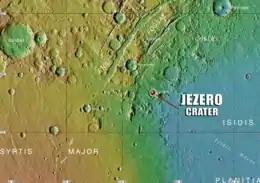
In 2007, following the discovery of its ancient lake, the crater was named after Jezero, Bosnia and Herzegovina, one of several eponymous towns in the country.[6][7] In some Slavic languages, the word jezero[lower-alpha 2] means 'lake'.[8]
In November 2018, it was announced that Jezero had been chosen as the landing site for the rover Perseverance as part of NASA's Mars 2020 mission.[9][10][11] In November 2020, evidence of boulder falls was found on the slopes of the delta deposits that the rover is planned to explore, on the wall of Jezero itself as well as on the wall of Dacono,[12] a small crater 2 km (1.2 mi) in diameter on the floor of Jezero.[13] Perseverance successfully landed in the crater on 18 February 2021.[14] On 5 March 2021, NASA named the landing site of the rover Octavia E. Butler Landing.[15]
Local features
- Séítah (pronounced /sei˥tʰa˩x/, meaning 'amidst the sand' in Navajo) — potentially the oldest, accessible geologic units in Jezero Crater with multiple outcrops between the numerous sand ripples; location where Perseverance started the first year of its scientific campaign and took the first core samples.[16]
In December 2021, NASA announced that some of the rocks in Jezero in Seitah were igneous. When examined closely, rocks revealed the mineral olivine surrounded by the mineral pyroxene. That arrangement happens in thick magma bodies and geologists call this type of texture "Cumulate."[17] Carbonate and sulfate minerals were also detected which means that the rocks had been altered by water.[18] The instrument used for this analysis was the Planetary Instrument for X-ray Lithochemistry (PIXL).[19]
Crater
In a March 2015 paper, researchers from Brown University described how an ancient Martian lake system existed in Jezero. The study advanced the idea that water filled the crater at least two separate times.[20] There are two channels on the northern and western sides of the crater that probably supplied it with water; each of these channels has a delta-like deposit where sediment was carried by water and deposited in the lake.[21] Craters of a given diameter are expected to have a certain depth; a depth less than expected means sediment entered the crater.[22] Calculations suggest that the crater may hold about 1 kilometre (0.62 mi) of sediments. Most of the sediments may have been brought in by channels.[23]
Since it is believed that the lake was long-lived, life may have developed in the crater; the delta may have required a period of one to ten million years to form.[23] Clay minerals have been detected in and around the crater.[24][25][26] The Mars Reconnaissance Orbiter identified smectite clays.[27] Clays form in the presence of water, so this area probably once held water and maybe life in ancient times. The surface in places is cracked into polygonal patterns; such shapes often form when clay dries out. The image below depicts examples of these patterns, and a channel that carried water and sediments into the crater.[3]
Geologic map of Jezero and the Nili Planum region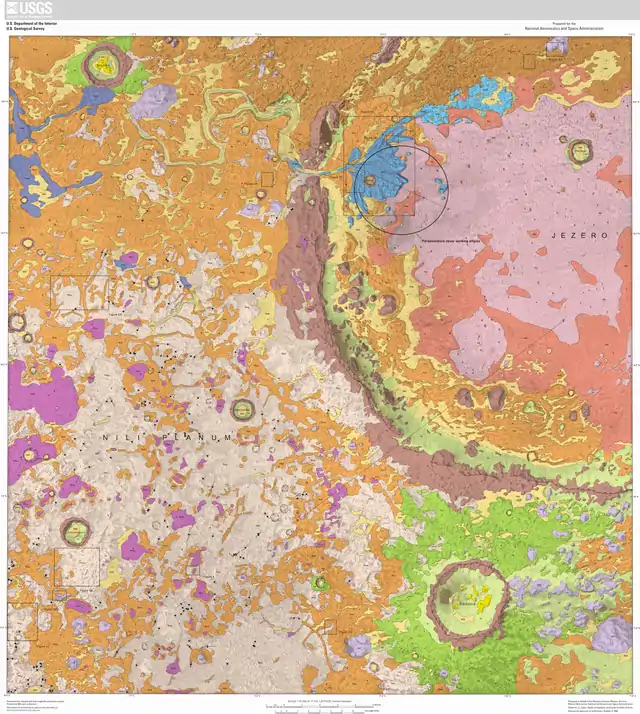 |
.jpg.webp) Elevation map of Jezero. Ancient rivers Neretva and Sava fed the crater from NW until the overflow flooding carved the outlet Pliva at the NE side of the crater rim 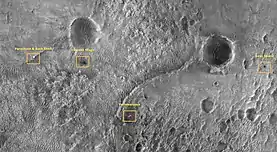 Perseverance's landing site in Jezero  Artist's concept of Jezero filled with a lake |
Exploration
Mars 2020 mission
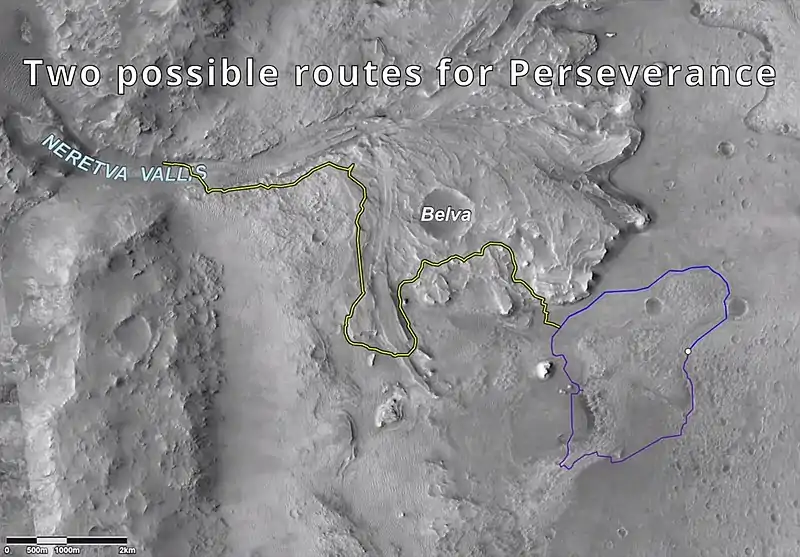
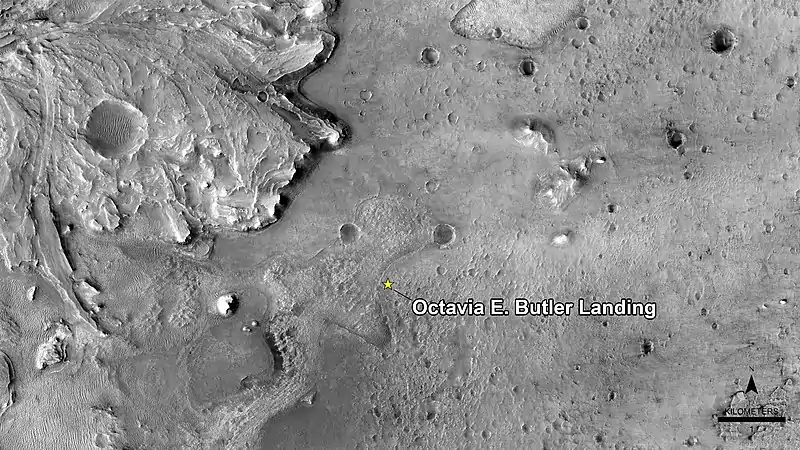

Jezero, once considered a site for the Mars Science Laboratory, was later proposed as a landing site for NASA's Mars 2020 mission, carrying the rover Perseverance and the helicopter Ingenuity.[28][29] In early 2017 it was selected as one of the top three candidate landing sites, along with northeast Syrtis, 30 km (19 mi) to the southwest.[30]
A primary aim of the Mars 2020 mission is to search for signs of ancient life. It is hoped that a later mission could then return Martian samples from sites identified as probably containing remains of life. To safely bring the craft down, a 12-mile (19 km) wide, smooth, flat circular area is needed. Geologists hope to examine places where water once ponded.[31] They would like to examine sediment layers.
In November 2018, Jezero was selected as the target landing site for Mars 2020.[32] On 18 February 2021, Perseverance landed successfully in the crater.[33] On 19 April 2021, Ingenuity performed the first powered flight on Mars from Jezero, which received the commemorative ICAO airport code JZRO.[34]
Mars Sample Retrieval Lander
An ESA–NASA team produced a three-launch architecture concept for a Mars sample return, which uses the Mars 2020 rover to cache small samples, a two-stage, solid-fueled Mars ascent stage to send it into orbit, and an orbiter to rendezvous with it above Mars and take it to Earth.[35] Solar-electric propulsion could allow a one launch sample return instead of three.[36] So, after a launch in July 2026, a lander with a Mars ascent rocket (developed by NASA) and a sample collection rover (developed by ESA) (or may be on two separate landers or a dual lander probe) lands exactly near the Mars 2020 rover in Jezero Crater in August 2028. The new rover collects the samples left behind by Mars 2020 and delivers them to the ascent rocket. If Mars 2020 is still operational, it could also deliver samples to the landing site. Once loaded with the samples, the Mars ascent rocket will launch with the sample return canister in spring 2029 and reach a low Mars orbit. The lander would bring a small and simple "fetch rover", whose sole function would be to retrieve the sample containers from the caches left on the surface or directly from the Perseverance rover, and return them to the lander where it would be loaded onto the MAV for delivery to the orbiter and then be sent to Earth.[37][38]
This design would ease the schedule of the whole project, giving controllers time and flexibility to carry out the required operations. Furthermore, the program could rely on the successful landing system developed for the Mars Science Laboratory, avoiding the costs and risks associated with developing and testing yet another landing system from scratch.[38] Even NASA may think of changing the Sample Return Lander into a two-lander or dual lander probe mission, one carrying a rover to collect samples and the other carrying the Complex Mars Ascent Vehicle that will launch the sample container into orbit. In addition, NASA may change the solar panels on lander with Radioisotope Thermoelectric Generator, a nuclear power source,or at least the lander with the MAV in case if fetch rover is launched separately, to ensure sufficient power and to keep the rocket’s propulsion system from getting too cold, thus ensuring a longer lifetime, better thermal protection and safe operation even if they are carried in Mars Global Dust Storm Season, but these changes are still to be clarified by NASA.
In 2022, the Perseverance Rover detected organic molecules in the crater.[39][40]
Interactive Mars map
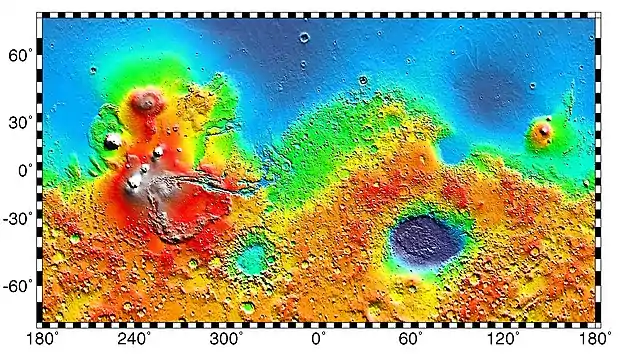
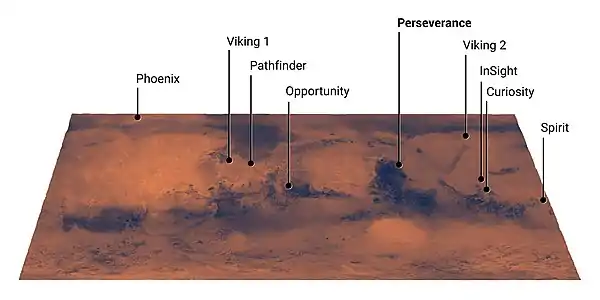
Gallery
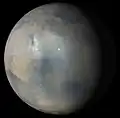 Dust storm on Mars - Jezero crater (white circle) (9 January 2022)
Dust storm on Mars - Jezero crater (white circle) (9 January 2022)
See also
- Astrobiology – Science concerned with life in the universe
- Climate of Mars – Climate patterns of the terrestrial planet
- Composition of Mars – Branch of the geology of Mars
- Exploration of Mars – Overview of the exploration of Mars
- Geology of Mars – Scientific study of the surface, crust, and interior of the planet Mars
- Impact crater – Circular depression on a solid astronomical body formed by a smaller object's impact
- Inverted relief – Landscape features that have reversed their elevation relative to other features
- Lakes on Mars – Overview of the presence of lakes on Mars
- List of craters on Mars
- Mars landing – Landing of a spacecraft on the surface of Mars
- Water on Mars – Study of past and present water on Mars
Notes
- The pronunciation is approximately /ˈjɛzəroʊ/ YEH-zə-roh (Serbo-Croatian: [jêzero]), but the name is commonly pronounced /ˈdʒɛzəroʊ/ JEH-zə-roh by the Mars 2020 mission team.[2]
- Bulgarian, Macedonian: езеро, Serbo-Croatian: jezero / језеро, Czech, Slovene: jezero and its closest written variations (Polish: jezioro, Lower Sorbian: jezer, Slovak: jazero, Russian and Ukrainian: озеро), as well as in Baltic languages (Lithuanian: ežeras, Latvian: ezers)[8]
References
- "Perseverance Rover's Landing Site: Jezero Crater". Mars 2020 Mission Perseverance Rover. NASA. Retrieved 12 March 2022.
- Urrutia, Doris Elin (18 February 2021). "How to pronounce 'Jezero crater.' (Yes, you may be doing it wrong.)". Space.com. Retrieved 5 April 2021.
- Wray, James (6 June 2008). "Channel into Jezero Crater Delta". NASA. Retrieved 6 March 2015.
- Muir, Hazel. "Prime landing sites chosen for biggest Martian rover". Retrieved 20 November 2018.
- Goudge, T.; et al. (2017). Stratigraphy and Evolution of Delta Channel Deposits, Jezero Crater Mars (PDF). Lunar and Planetary Science 48 (2017). 1195.pdf.
- "NASA Mars Mission Connects With Bosnian Town". jpl.nasa.gov. Jet Propulsion Laboratory. 23 September 2019. Retrieved 18 February 2021.
- "Planetary Names: Crater, craters: Jezero on Mars". planetarynames.wr.usgs.gov. Retrieved 14 December 2018.
- Trubachyov, Oleg Nikolayevich, ed. (1979). Etimologicheskiy slovar' slavyanskikh yazykov Этимологический словарь славянских языков [Etymological Dictionary of Slavic Languages] (in Russian). Vol. 6. Moscow: Nauka. p. 33–34.
- Chang, Kenneth (28 July 2020). "How NASA Found the Ideal Hole on Mars to Land In - Jezero crater. the destination of the Perseverance rover, is a promising place to look for evidence of extinct Martian life". The New York Times. Retrieved 28 July 2020.
- Chang, Kenneth (19 November 2018). "NASA Mars 2020 Rover Gets a Landing Site: A Crater That Contained a Lake - The rover will search the Jezero Crater and delta for the chemical building blocks of life and other signs of past microbes". The New York Times. Retrieved 21 November 2018.
- Wall, Mike (19 November 2018). "Jezero Crater or Bust! NASA Picks Landing Site for Mars 2020 Rover". Space.com. Retrieved 20 November 2018.
- "Dacono". Gazetteer of Planetary Nomenclature. IAU Working Group for Planetary System Nomenclature. Retrieved 22 September 2021.
- Sinha, R.K.; et al. (2020). "Boulder fall activity in the Jezero Crater, Mars". Geophysical Research Letters. 47 (23): e90362. Bibcode:2020GeoRL..4790362S. doi:10.1029/2020GL090362. S2CID 228859524.
- Billings, Lee. "Perseverance Has Landed! Mars Rover Begins a New Era of Exploration". Scientific American. Retrieved 18 February 2021.
- Staff (5 March 2021). "Welcome to 'Octavia E. Butler Landing'". NASA. Retrieved 5 March 2021.
- "Perseverance's First Road Trip". NASA/JPL. 23 July 2021. Retrieved 25 November 2021.
- "Nasa's Perseverance Mars rover finds its 'baseline' rocks". BBC News. 16 December 2021.
- "Nasa's Perseverance Mars rover finds its 'baseline' rocks". BBC News. 16 December 2021.
- "NASA's Perseverance Mars Rover Makes Surprising Discoveries". Jet Propulsion Laboratory.
- "Ancient Martian lake system records two water-related events". ScienceDaily. 25 March 2015. Retrieved 20 November 2018.
- "Ancient Martian Lake System Records Two Water-related Events - SpaceRef". spaceref.com. Retrieved 20 November 2018.
- Garvin, J., S. Sakimoto, J. Frawley (2003). Craters on Mars: Global geometric properties from gridded MOLA topography. Sixth International Conference on Mars. Abstract no. #3277.
{{cite conference}}: CS1 maint: multiple names: authors list (link) - Schon, S.; Head, J.; Fassett, C. (2012). "An overfilled lacustrine system and progradational delta in Jezero crater, Mars: Implications for Noachian climate". Planetary and Space Science. 67 (1): 28–45. Bibcode:2012P&SS...67...28S. doi:10.1016/j.pss.2012.02.003.
- Bibring, J.; et al. (2006). "Global mineralogical and aqueous Mars history derived from OMEGA/Mars Express data". Science. 312 (5772): 400–404. Bibcode:2006Sci...312..400B. doi:10.1126/science.1122659. PMID 16627738. S2CID 13968348.
- Mangold, N.; et al. (2007). "Mineralogy of the Nili Fossae region with OMEGA/Mars Express data: 2. Aqueous alteration of the crust". Journal of Geophysical Research. 112 (E8): E08S04. Bibcode:2007JGRE..112.8S04M. doi:10.1029/2006JE002835.
- Poulet, F.; et al. (2005). "Phyllosilicates on Mars and implications for early Martian climate". Nature. 438 (7068): 623–627. Bibcode:2005Natur.438..623P. doi:10.1038/nature04274. PMID 16319882. S2CID 7465822.
- Murchie, S.; et al. (2009). "A synthesis of Martian aqueous mineralogy after 1 Mars year of observations from the Mars Reconnaissance Orbiter" (PDF). Journal of Geophysical Research. 114 (E2): E00D06. Bibcode:2009JGRE..114.0D06M. doi:10.1029/2009JE003342.
- Staff (4 March 2015). "PIA19303: A Possible Landing Site for the 2020 Mission: Jezero Crater". NASA. Retrieved 7 March 2015.
- Caleb Fassett; Bethany Ehlmann; Jim Head; Scott Murchie; Jack Mustard; Sam Schon. "Jezero Crater Lake: Phyllosilicate-bearing sediments from a Noachian valley network as a potential MSL landing site" (PDF). Retrieved 19 December 2020.
- Witze, Alexandra (11 February 2017). "Three sites where NASA might retrieve its first Mars rock". Nature. Bibcode:2017Natur.542..279W. doi:10.1038/nature.2017.21470. Retrieved 26 February 2017.
- Staff (2010). "The Floods of Iani Chaos". NASA. Retrieved 7 March 2015.
- Mandelbaum, Ryan F. "NASA's Mars 2020 Rover Will Land in Jezero Crater". Gizmodo. Retrieved 20 November 2018.
- "Touchdown! NASA's Mars Perseverance Rover Safely Lands on Red Planet". JPL. Retrieved 18 February 2021.
- "NASA's Ingenuity Mars Helicopter Succeeds in Historic First Flight". Mars Exploration Program. NASA. 19 April 2021. Retrieved 19 April 2021.
- Planetary Science Decadal Survey Mission & Technology Studies. Sites.nationalacademies.org. Retrieved on 2012-05-10.
- Oh, David Y. et al. (2009) Single Launch Architecture for Potential Mars Sample Return Mission Using Electric Propulsion. JPL/Caltech.
- 'Bringing back Mars life' MSNBC News, February 24, 2010 by Alan Boyle
- Witze, Alexandra (15 May 2014). "NASA plans Mars sample-return rover". Nature. 509 (7500): 272. Bibcode:2014Natur.509..272W. doi:10.1038/509272a. PMID 24828172.
- "Did life ever exist on Mars? NASA's Perseverance rover finds organic matter in rock samples".
- "Perseverance rover collects organics-rich Mars samples for future return to Earth". Space.com. 15 September 2022.
Further reading
- Ehlmann, B.L.; Mustard, John F.; Fassett, Caleb I.; Schon, Samuel C.; Head Iii, James W.; Des Marais, David J.; Grant, John A.; Murchie, Scott L. (2008). "Clay minerals in delta deposits and organic preservation potential on Mars" (PDF). Nature Geoscience. 1 (6): 355–358. Bibcode:2008NatGe...1..355E. doi:10.1038/ngeo207.
- Schon; et al. (2008). Meander Loops and Point Bar Sequences - Evidence of a Stable Delta Plain Environment in Jezero crater (PDF). Lunar and Planetary Sciences conference.
External links
- Jezero Crater – DataSheet (14 January 2017)
- Jezero Crater – Workshop Images/Details (4 August 2015)
- Perseverance rover: Official website
- Mars 2020: Official website
- Mars 2020: Location Maps
- Video – FlyOver bw (01:20) and color (02:20) (SDoran; 21 April 2017)
- Video – Mars 2020 Site News (01:00) (NASA; 19 November 2018)
- Video – Mars 2020 Site News (00:50) (MSN; 19 November 2018)
- Video – Mars 2020: Jezero crater flyover (02:13) (NASA; 13 December 2018)
- Video − Mars 2020: Landing on Mars (3:25) on YouTube (NASA; 18 February 2021)
- Video (60:00) - Minerals and the Origins of Life - (Robert Hazen; NASA; April 2014)
- Video (86:49) - Search for Life in the Universe - (NASA; July 2014)



.jpg.webp)